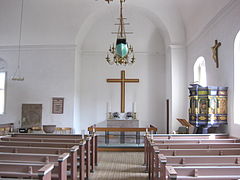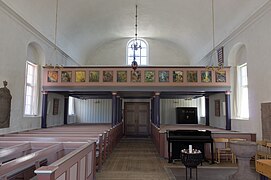Nexø Church
The Evangelical Lutheran Church of Nexø , the second largest town on the Danish island of Bornholm , is essentially late Gothic and was originally a small rectangular chapel for the seafarers of a fishing village that was built in the 14th century. It was under the patronage of St. Nicholas , the patron saint of seafarers. For a long time she belonged to the parish of Bodilsker ; Nexø has only had a parish since 1921 .
History and architecture
The church today consists of
- the late Gothic chapel from the 14th century, today's nave, which was raised by around 2.5 m from 1730–31,
- the tower in the Renaissance style from the 16th century with an onion-shaped spire from 1910, the wind vane bears the year 1911,
- a northern vestibule from 1745, which was previously called the ossuary and was probably also used,
- a transept-like north wing from 1760, in which a gallery was built in 1828,
- the originally late medieval vestibule in the south, in its current version from 1777
- and a sacristy built around 1800 on the east wall of the nave , on the north wall of which a low extension with a pent roof was added in 1985 . At the same time, the wall of the nave to the sacristy was broken to create a chancel.
The church was on 7./8. May 1945, when the rest of Denmark had already been liberated from German occupation, badly damaged by a Russian bombing and rebuilt in 1946.
The nave and the lower three storeys of the tower are made of hewn fieldstone, the bell storey of the tower and the north porch are made of half-timbered, the north wing and the south porch are made of sandstone. The spire is covered with copper, the northern vestibule with wood, the other roofs with tiles.
Furnishing
The nave and north wing have a flat, plastered, wooden barrel vault. The vault in the north wing was painted with a cloudy sky when it was built, the vault in the nave is whitewashed. The northern vestibule has a wooden ceiling divided into three compartments, two of which were decorated with painted medallions with biblical motifs when it was built.
The parapets of the organ gallery and the gallery in the north wing were painted with biblical motifs by Bodil Kaalund in 1993–95.
The sandstone altar comes from the 1985 renovation, and a modern cross hangs on the wall behind it. Two earlier altar panels, one in the Renaissance style from the 16th century and one from the 17th century, which was rebuilt in 1735, are now hung in the tower room. In the older one there is a copy of a painting by the Danish painter Anton Dorph (1831–1914), which shows Jesus with Mary and Martha in Bethany (Lk 10, 38–42). The two brass candlesticks on the altar were a gift from the Danish Crown Prince couple Frederik and Ingrid on the occasion of the rebuilding of the church in 1946.
The sandstone baptismal font dates from 1784.
The pulpit is a Renaissance work from the end of the 16th century, the five panels show creation, the birth of Christ, resurrection and ascension and Pentecost. The paintings were created by Bodil Kaalund together with those on the galleries in 1993–95. The crucifix above the pulpit probably dates from the 17th century and probably originally hung in the younger, earlier altar panel.
The two Danish bells were cast in 1856 and 1912, the organ of the Danish organ builder Frobenius was built in 1964.
Web links
Individual evidence
- ↑ The Second World War on Bornholm , bornholm.info
- ↑ a b Nexø Church , accessed January 31, 2020.
- ↑ a b Nexø Kirke , (Danish), accessed on January 31, 2020.
- ↑ a b Bornholms Museum (Ed.): Bornholms Alte Kirchen , 1999, ISBN 87 881 79 41 9 .
Coordinates: 55 ° 3 ′ 38 ″ N , 15 ° 7 ′ 56 ″ E




